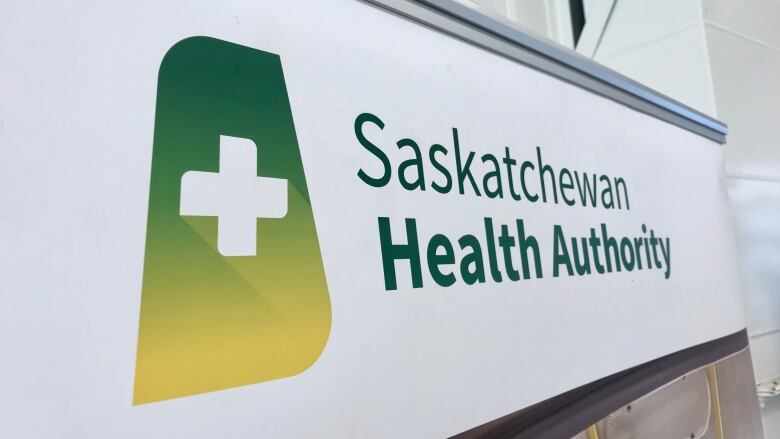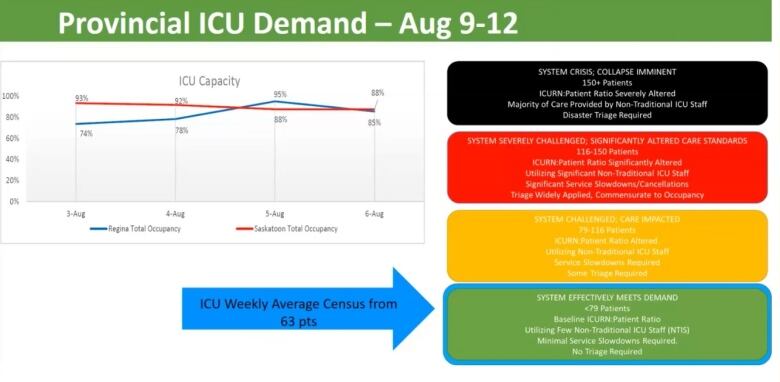Sask. health workers are burning out, plus 3 other takeaways from this week's COVID-19 check-in
'Exodus of nursing staff' flagged at Saskatoon's Royal University Hospital

The Saskatchewan government recentlyceased its regularnews conferences to discuss the province's COVID-19 situation, but physicians with the Saskatchewan Heath Authority (SHA) have kept meeting to discuss the latest challenges they're facing during the pandemic and posting about it online.
Their latest virtual town hallwas on Thursday night.
Here are four takeaways.
1. Despite health restrictions being lifted, 'we're still in a pandemic'
That was the message delivered by Cory Neudorf, asenior medical health officer at the health authority.
Saskatchewan's test positivity rate began inching upwards one month ago. As of Thursday, it stood at five per cent, compared to around two per cent on July12.

2. Staff shortages could be a problem during a 4th wave
The intensive care units in Saskatoon and Regina currently have enough staff to meet demand, according to this slide:

But overall, health system remains under pressure, saidDr. Kevin Wasko, the SHA'sphysician executive for integrated rural health, in an interview with CBC News just hours before the town hall.
"If we were to have a fourth wave come [in the] fall, it would look very different than what that looked like previously in the pandemic, because we don't have the capacity anymore to surge like we did," he said.
The sustained stress of the pandemic has taken its toll on health-care workers, Wasko said.
"What's different now than was the case early on in the pandemic is that people are tired, people are burnedout, there are people who have left the system, whether it's because they decided this isn't the profession for them or they opted to retire because they were eligible to do so. And what it has caused is a very real labour shortage," he said.

Rural Saskatchewan and the province's urban centres are feeling the pinch, Waskosaid.
"The emergency department at [Saskatoon's Royal University Hospital], for instance, has had an exodus of nursing staff. In rural Saskatchewan, we're having to put hospitals on diversion because we can't staff the facilities with nurses or physicians because people are tired, and they're not wanting to work overtime and put in that extra time when they've had such a long go over the past year and a half."
3. What can people do? Get vaccinated
People should also still mask up when in crowded indoor spaces.

4. Our vaccine rates are lagging
As of Thursday, 64.9 per cent of the Saskatchewan population eligible for vaccination (people aged 12 and up) have been fully vaccinated.
That's lower than every other province in Canada but one.

Regionally, full vaccine take-up in Saskatchewan ranges from as low as 33 per cent in the province's far north central (a sparsely-populated area that includesUranium City, Fond-du Lac and Stony Rapids) to as high as 70 per cent in Regina, the provincial capital.
The lower uptake in parts of the north comes despite the fact that people in northern Saskatchewan had earlier access to the vaccine than their southern counterparts.

Wasko said there's an array of reasons why Saskatchewan peopleare choosing not to get vaccinated.
"There is some skepticism about the vaccine," he said."There's definitely some misinformation or the perception that if you're young and healthy, you're not going to get sick anyway. And there is definitely a contingent of people who have really bought into that anti-COVID,anti-mask, anti-vaccine story or narrative. It is out there and it is alive and well, unfortunately."
with files from Samantha Maciag












_(720p).jpg)


 OFFICIAL HD MUSIC VIDEO.jpg)
.jpg)



























































































